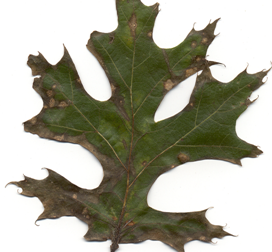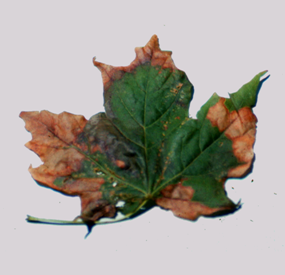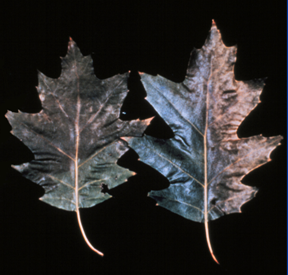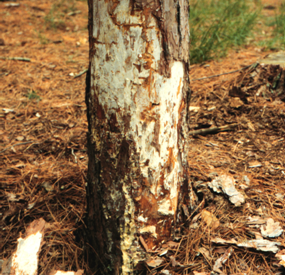
What is Tubakia (Actinopelte) leaf spot?
Tubakia leaf spot (formerly Actinopelte leaf spot) is a common late-season leaf disease of oaks. All species of oak appear to be susceptible to the disease, but oaks in the red oak group (i.e., oaks with pointed-lobed leaves) such as black, red and pin oak) appear to be most susceptible.
What does Tubakia (Actinopelte) leaf spot look like?
People often confuse symptoms of Tubakia leaf spot with those of oak anthracnose. However anthracnose tends to develop earlier, in the cooler part of the growing season (May and June); Tubakia leaf spot tends to develop later, during the warmer summer months (July and August). Initial symptoms of Tubakia leaf spot include small to large dark brown or reddish-brown spots on leaves. Spotting can occur on leaf veins, and death of the veins leads to collapse of leaf tissue beyond the point of infection. Small twig cankers may also form. When the disease is severe, Tubakia leaf spot can cause early defoliation of oaks. However, disease usually develops late enough in the growing season that no long-term adverse effects on tree health occur.
Where does Tubakia (Actinopelte) leaf spot come from?
Tubakia leaf spot is caused by the fungus Tubakia dryina (formerly Actinopelte dryina), a fungus that is most likely a fungus “complex” (i.e., a group of several distinct, but closely related fungi). Tubakia overwinters in infected twigs, and in dead leaves that hang from the tree or are scattered on the ground. Spores of the fungus are easily spread by wind and rain splash.
How do I save a tree with Tubakia (Actinopelte) leaf spot?
Don’t panic! In most cases Tubakia leaf spot is a cosmetic disease. The disease will make a tree look a little ragged, but will not kill the tree. Do not attempt to use fungicide sprays to control this disease.
How do I avoid problems with Tubakia (Actinopelte) leaf spot in the future?
Reduce the amount of Tubakia dryina in your landscape by removing and disposing of fallen, infected leaves by burning (where allowed by local ordinance), burying or hot composting them. When composting, make sure that the pile reaches high temperature (approximately 140°F), and be sure to routinely turn the pile, so that leaves on the outside of the pile eventually end up in the center of the pile. The combination of high temperature and leaf decay helps eliminate the Tubakia leaf spot fungus. Also, maintain good tree vigor. Established trees require approximately one inch of water per week from natural rain or supplemental watering at the drip line of the tree (i.e., the edge of where the branches extend). Fertilize trees as needed based on soil nutrient testing.
For more information on Tubakia (Actinopelte) leaf spot:
Contact the University of Wisconsin Plant Disease Diagnostics Clinic (PDDC) at (608) 262-2863 or pddc@wisc.edu.
Authors: Gina Foreman* and Brian Hudelson, UW-Madison Plant Pathology
Last Revised: 03/02/2024
D-number: D0118
* Completed as partial fulfillment of the requirements for a MS in Plant Pathology at the University of Wisconsin Madison.
References to pesticide products in this publication are for your convenience and are not an endorsement or criticism of one product over similar products. You are responsible for using pesticides according to the manufacturer’s current label directions. Follow directions exactly to protect the environment and people from pesticide exposure. Failure to do so violates the law.
Thanks to Karen Delahaut, Ann Joy, and Phil Pellitteri for reviewing this document.
A complete inventory of UW Plant Disease Facts is available at the University of Wisconsin-Madison Plant Disease Diagnostics Clinic website: https://pddc.wisc.edu.
Send a Plant Sample for Analysis
Be cautious when self-diagnosing plant health issues. Very few diseases can accurately be diagnosed by eye.
Contact the UW Plant Disease Diagnostics Clinic (PDDC), and for a small fee, clinic staff can examine a plant, determine the cause of the disease/disorder, and provide advice on how to control or prevent the issue.
Download Article





 Anthracnose
Anthracnose Oak Wilt
Oak Wilt Chlorosis
Chlorosis Armillaria Root Disease
Armillaria Root Disease


